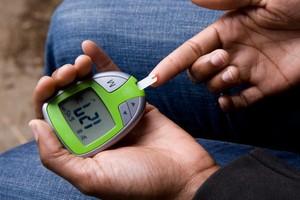Diabetes to be a major problem in today’s society and among the lead causes of death in Dominica, statistics from the World Health Organization have shown.
Additionally, Pan American Health Organization (PAHO) Representative for Barbados and the Eastern Caribbean, Dr. Godfrey Xuereb said obesity in adults has reached ‘epidemic proportion’ on the island.
Speaking at the Dominica Diabetes Association (DOMDA) Annual General Meeting (AGM) held at the Public Service Union (PSU) building on Wednesday, he said World Health Organization statistics, published in April, show that 1 in 10 adults have diabetes in Dominica. He said over the last 30 years, the number of persons diagnosed with diabetes has increased.
“This in itself is a worrying statistic but even more worrying, is the trend,” he noted. “Over the last 30 years those diagnosed with diabetes in Dominica have risen from just over 5 percent, so 5 for every 100 in 1980 to almost 15 percent, so 15 for every 100 in 2014.”
He said the number of female diabetics has tripled in one generation and the data for men is equally grim.
“The data shows that in 1980, we has about just under 5 percent of men with diabetes and in 2016 we have 10 percent, so the number of men with diabetes has also doubled,” he noted.
Dr. Xuereb stated that one of the most important risk factors for diabetes is obesity, “and here the data is even more alarming for Dominica.”
“The same WHO report from earlier this year shows that over half of men and over 60 percent, so 6 of every 10 women are overweight and a third of all women are classified as obese,” he noted.
He stated further that over a quarter of all adults in Dominica are now classified as obese.
“Obesity in adults have reached epidemic proportions and is manifesting itself in the number of cases of diagnosed diabetics and persons with high blood pressures as well as problems associated with these two silent killers,” he explained. “The problem gets worst when we see what is happening to our younger generation, the generation of the future, the ones who should be carrying Dominica to the next decades.”
Dr. Xuereb indicated that the latest global school-based student health survey conducted in Dominica in 2009 revealed that a quarter of all students, age 13 to 15 were overweight, “and 1 in every 10 students in that age group was obese.”
“In one generation we have moved from under nutrition to obesity and overweight,” he noted.
He stated that a second major risk factor is the lack of physical activity.
“PAHO data from 2007 shows that one-third of all female adults in Dominica do not do enough physical activity,” Dr. Xuereb said. “This figure gets worst in 2011. WHO reported that 4 in every 10 adult women were physically inactive and in men, it’s not much better. In 2007, 14 of every 100 men were physically inactive and this went up to 18 out of every 100 men in the 2016 report, so now almost 2 out of every 10 men are physically inactive in Dominica.”
He also mentioned that 76 percent of adolescents 13 to 15 did not do at least 60 minutes of physical activity per day.
“Three quarters of our adolescence are inactive,” Dr. Xuereb remarked. “They are obese and inactive, two of the key factors that lead to diabetes.”
He said the food and energy data for Dominica from 1964 and 2000 revealed that the average daily intake of calories have moved from just under 1,900 calories per person in 1965 to almost 3000 calories per person in 2000.
“This is over 500 calories more that the WHO recommends for adults intake,” he said.
He noted that the fat contribution to the diet has moved from just under 20 percent in 1965 to 25 percent which is about 700 calories in 2000.
“Out of the 500 extra calories that we are eating, 360 are coming from fat…our diet have not only become high in calories, but that extra calorie is coming from fat,” he stated.
He said the major food imports and exports from Dominica, the percentage of energy that is imported in 1964 was 60 percent.
“In 1997 this became 113 percent, so we are not eating foods locally produced,” he stressed. “We are importing foods high in fat, high in sugar. We are eating more and exercising less.”
Meantime, various Diabetes Associations across the island were recognized today and were presented with certificates.
They are the Grandbay Diabetes Association, Castle Bruce Diabetes Association, Salisbury Diabetes Association, Dublanc Diabetes Association, Penville Diabetes Association and Roseau Diabetes Association.
The DOMDA is observing their AGM under the theme: “Waste the Waist.” (Dominica News Online)














